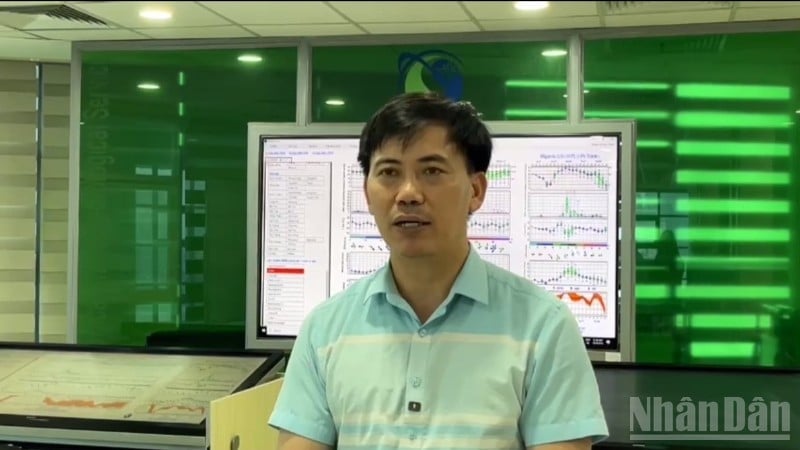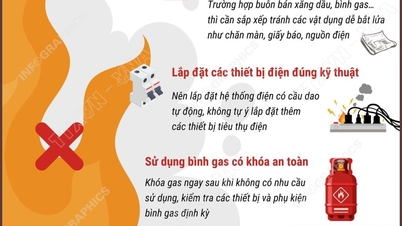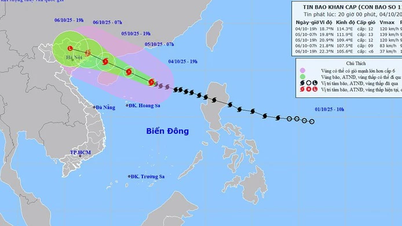In an interview with the press on October 4, Mr. Nguyen Van Huong, Head of the Weather Forecast Department, National Center for Hydro-Meteorological Forecasting, warned that storm No. 11 has a wide circulation, strong winds of level 8-9 in Quang Ninh and can cause dangerous thunderstorms and tornadoes in the Northern region before making landfall.

Reporter: Sir, up to now, what is the position and development of storm number 11?
Mr. Nguyen Van Huong : As of 10 o'clock this morning, storm is still about 500km east-northeast of the Paracel Islands. It is forecasted that in the next 24 hours, the storm will continue to move west-northwest, intensifying, possibly reaching level 13.
According to our calculations, the storm is likely to move northward in the coming time. With this direction of movement, the storm is likely to enter the area between Quang Ninh province and Guangxi province (China), the strongest intensity can reach level 8-9 in the Quang Ninh area; other areas have strong winds of level 6-7.
Due to the influence of the storm circulation, from the night of October 5 to October 7, the Northern region will have a widespread rainstorm. In particular, if the storm moves north, the rain will concentrate in the mountainous and midland areas of the North, with total rainfall ranging from 150mm to 250mm. The Northern Delta and Thanh Hoa regions will have lower rainfall, ranging from 70mm to 120mm, with some places exceeding 200mm.
Reporter: When entering the East Sea, storms tend to intensify. Could you please tell us why storms intensify?
Mr. Nguyen Van Huong: When storms enter the East Sea, their intensity tends to increase because this area has relatively favorable conditions for storm development.
Our monitoring shows that the sea surface temperature in the East Sea is currently around 28°C-29°C, while 26°C-27°C is considered a good condition for storm activity and intensity. In addition, the wind shear in this area is also small, creating conditions for moisture to accumulate and develop in the storm structure.
Therefore, in the next 24 to 48 hours, the storm is forecast to continue to strengthen. However, when moving through the northern area of Loi Chau Island and entering the Gulf of Tonkin, the storm's intensity will gradually decrease. The reason is that the storm is affected by friction with the ground and the wind shear in this area increases.
According to the assessment, Quang Ninh area is likely to experience strong winds of level 8-9, which is also the strongest wind intensity when the storm directly affects.
Reporter: Could you tell us how the storm's wind strength might affect the mountainous areas of Quang Ninh province?
Mr. Nguyen Van Huong: The coastal area of Quang Ninh is the area directly affected, with strong winds of level 8-9. Further inland areas of Quang Ninh province are likely to experience strong winds of level 6-7. The storm's circulation can also cause strong winds of level 6-7 in neighboring provinces such as Lang Son and Bac Giang (old).
In addition, we note that during this storm, not only rain and strong winds but also thunderstorms and tornadoes before and during the storm are very dangerous and require special attention.
We emphasize in the news that, with storm No. 11, the storm circulation is quite wide. Therefore, even if the storm has not made landfall directly, thunderstorms and tornadoes may still appear in the front part of the storm, causing great impacts on houses and people's lives, especially in the Gulf of Tonkin and the Northern region.
Source: https://baolangson.vn/chuyen-gia-canh-bao-hoan-luu-bao-so-11-kha-rong-co-the-gay-dong-loc-truoc-khi-do-bo-5060859.html




![[Photo] Bustling Mid-Autumn Festival at the Museum of Ethnology](https://vphoto.vietnam.vn/thumb/1200x675/vietnam/resource/IMAGE/2025/10/4/da8d5927734d4ca58e3eced14bc435a3)
![[Photo] Solemn opening of the 8th Congress of the Central Public Security Party Committee, term 2025-2030](https://vphoto.vietnam.vn/thumb/1200x675/vietnam/resource/IMAGE/2025/10/4/f3b00fb779f44979809441a4dac5c7df)

![[Photo] General Secretary To Lam attends the 8th Congress of the Central Public Security Party Committee](https://vphoto.vietnam.vn/thumb/1200x675/vietnam/resource/IMAGE/2025/10/4/79fadf490f674dc483794f2d955f6045)
















































![[VIDEO] Summary of Petrovietnam's 50th Anniversary Ceremony](https://vphoto.vietnam.vn/thumb/402x226/vietnam/resource/IMAGE/2025/10/4/abe133bdb8114793a16d4fe3e5bd0f12)

![[VIDEO] GENERAL SECRETARY TO LAM AWARDS PETROVIETNAM 8 GOLDEN WORDS: "PIONEER - EXCELLENT - SUSTAINABLE - GLOBAL"](https://vphoto.vietnam.vn/thumb/402x226/vietnam/resource/IMAGE/2025/7/23/c2fdb48863e846cfa9fb8e6ea9cf44e7)


























Comment (0)